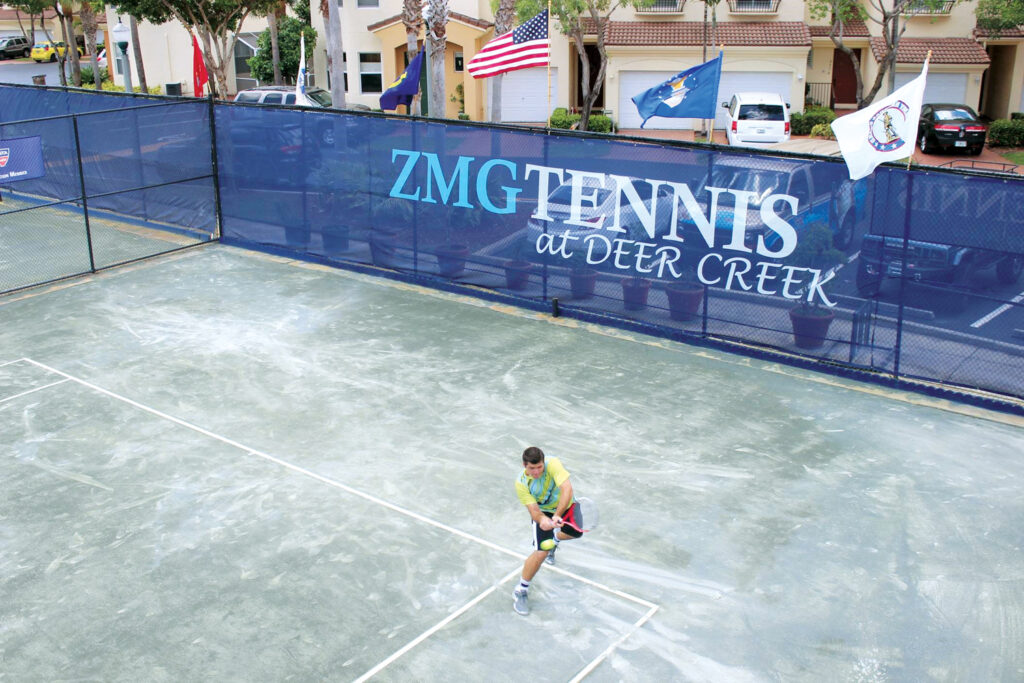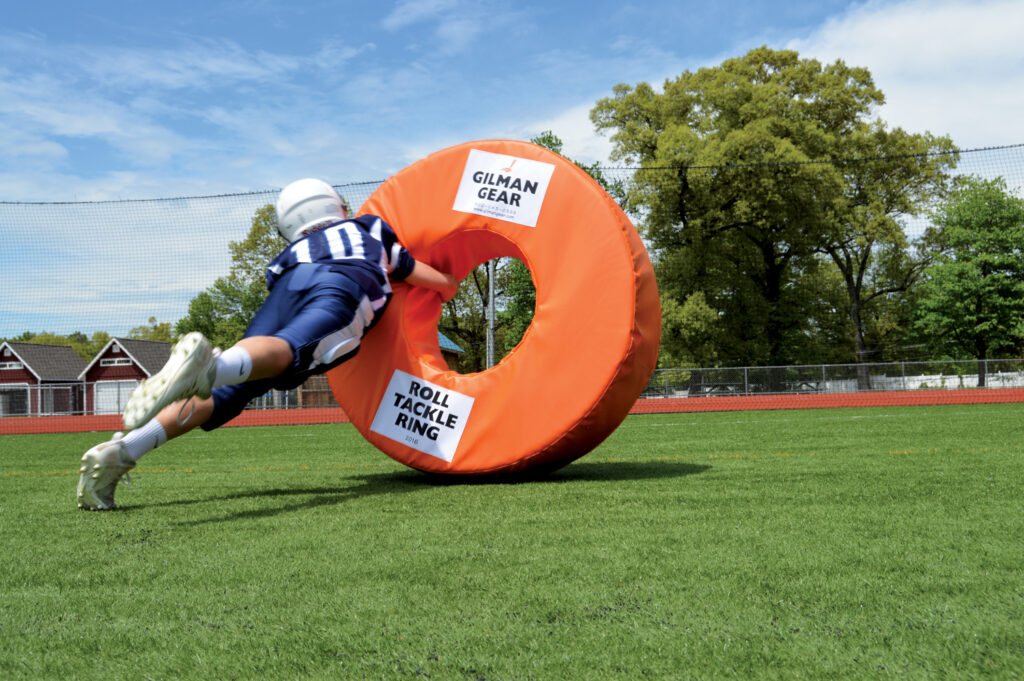
When high schools and colleges resume classes every fall, outdoor sports are underway too. Outdoor fabrics play a key role in training and in the way stadiums and other sports facilities look.
Sports fans revere their teams’ colors, mascots and logos, and organizations aim to create home field advantage (and branding) by visually proclaiming whose turf you’re on. From field covers to pads, practice gear to advertising banners, fabrics are integral to making home field into fans’ favorite place to be on a chilly fall night or a bright spring day.
CoverSports products decorate the fields
Founded in 1874, CoverSports entered the outdoor fabrics sports market in the mid-1990s after discovering the margins for sports field covers were better than those for tarps and other products the company was making. It began with screen-printed athletic field and fence covers, winter turf blankets, pole vault landing mats and printed banners using cotton canvas. Now these products are made of PVC-coated woven polyethylene and polypropylenes, banner polyester, and mesh and are printed on using high-tech digital printers. These fabrics remain dominant because of their reasonable cost, high strength and printability. Other fabrics don’t work because they are not durable outdoors, they’re too expensive, or the ink can’t penetrate them and flakes off.
Customers want school logos on everything. “Our products dress up the field from Little League® to big league,” says CEO Ron Nissenbaum. “No matter the size of the team or school, they want their name, their advertising partners, and all promotional banners and signage in the athletic field or stadium to look great.”
New printers increase production speed
CoverSports started digitally printing banners on PVC 20 years ago. “Newer printers are faster, the inks are better and the software is friendlier,” Nissenbaum says. “These new printing machines can use more than one type of fabric. In printing windscreens and banners, the ink required may cost more than the fabric per square foot. One must constantly be aware of what is new in the marketplace.” He recommends attending trade shows and visiting with sales reps to learn about new technology and maintain competitiveness.
One important benefit of these new machines is their ability to match colors, which matters to customers. “The whole idea is branding,” Nissenbaum says. “We must match [Pantone] colors for customers. Can you imagine if we don’t have the right shade of red for Alabama football’s Crimson Tide or the right blue and orange for the Florida Gators? The print machine software’s ability to deliver the correct shade is essential.” Using that software, his graphics staff can usually match any color easily.
Adding new printers is not cheap. Nissenbaum says small flatbed printers start at $60,000. The four EFI™ printers that CoverSports has now cost at least $500,000 each. “We are evaluating a new $900,000 5-meter [16.4-foot] printer that has great speed and print ability,” he says. “This would be a huge investment, but if it saves time in processing and in the labor to run it, it may pay for itself in a few years. We are always looking at machinery that will save labor expense.” Because new printers reduce costs, CoverSports can provide affordable sports field products for public high schools with tight budgets as well as costlier banners for high-end private schools and major college sports programs with generous budgets.
“Faster is the name of the game in manufacturing,” Nissenbaum says. “We invest in machinery to help us be a low-cost manufacturer and still meet our customers’ needs with quality products. One must also be vigilant in the licensing of the software and the maintenance contract on sophisticated printing machines. The technicians who service these units are highly trained and paid. These machines do need servicing!”
Gilman Gear’s football training products take abuse
When Marty Gilman founded Marty Gilman Inc. (now doing business as Gilman Gear) in 1929, he created a new industry segment. A former University of Connecticut football player, he invented football training equipment, including blocking and tackling sleds, dummies, shields and other training aids. Previously, players were injured frequently while they trained on each other.
“We build football training equipment for all levels of football, including the NFL, college, high school and Pop Warner football,” says company president Neil Gilman, son of the founder. “We use the same high-quality rugged materials for all teams. We scale down the size and weight of the sleds, dummies and shields based on the size and weight of the players using them. Gilman dummies are built with an armor shell of 18-ounce vinyl-coated polyester and a bottom boot made from 22-ounce vinyl-coated polyester. These materials stand up to the punishment on the football practice field.”
Gilman Gear uses stock colors of red, blue and yellow for most products. “Sometimes a school will request a school color and we go to great lengths to try and match it,” he says. “If it’s for goalpost pads, we can digitally print any color.” For blocking dummies, the company is limited to the colors manufactured by its vinyl-coated polyester supplier. This new popularity of using school colors is a key challenge Gilman Gear faces. “We hold back a large volume of foam cores until we know what color shell is being ordered,” he says. “The customization of colors slows down the manufacturing process and increases the finished product cost.”
New additives and old and new machines
Gilman football dummies were originally made with heavy canvas covers. In the 1970s, the fabric evolved into vinyl-coated nylon, transitioning to vinyl-coated polyester in the 1990s. Since then, there have been no breakthroughs in the outdoor fabrics’ durability. New regulations in some states call for compliance with the Consumer Product Safety Improvement Act (CPSIA), meaning no lead is allowed in the fabric. In addition, some customers request additives to protect against mold and fungus. “Because many of our products are used outdoors, we specify UV stabilizers in our 18-ounce vinyl polyester material to reduce the amount of deterioration caused by the sun,” Gilman says.
Gilman Gear bought an Eastman Eagle C125 automated cutting machine in 2017 to speed up cutting, but employees were resistant to learning this new technology. Having it (and hiring a retired expert machine cutter to operate it) and an old Merrow® serger enabled the company to get a surgical gown contract in 2020. Ten more sergers and two machines to insert and close wrist elastic were also purchased. This allowed Gilman to stay in business making 10,000 surgical gowns weekly during the pandemic when schools were not playing sports. One new Merrow remains in use on two football products. The company is searching for a new worker to operate the Eastman cutter.

Long-lasting products
Depending on the fabric strength, some infield tarps can last between seven and 10 years, while windscreens are usable for five to 10 years. Nissenbaum says climate has a big effect on outdoor sports’ product longevity. The near-constant sun in Arizona and Florida shortens an outdoor fabric’s life span. “Some high jump and pole vault pits and mats are outdoors 24/7,” he notes. “Outfield wall padding attached to the wall will last up to 10 years. Most fabrics used outdoors are designed to resist tearing and UV degradation.”
“Gilman Gear products are famous for their longevity,” says Gilman. “We print a ‘born on’ date on all fabric products. This way our customers know how many years of service they are getting. Our customers often call and tell us they have a sled pad, blocking shield or dummy that is 20 years old they are still using.”
Hopes for future materials
While the industry trend is for manufacturers to find ways to reduce costs, Gilman says his company won’t compromise on quality to do this. “I’d like to find better materials, but I haven’t seen anything new in fabric technology yet,” he says.
Nissenbaum wants to print on woven polyethylene without the ink flaking off. He says it will take new chemistry to make it more ink receptive. Textile manufacturers will have a ready market when they can provide new fabrics to meet these requests.
Jean Feingold is a freelance writer based in Gainesville, Fla.
 TEXTILES.ORG
TEXTILES.ORG


